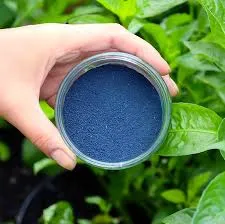Insights on Indigo's Impact on Manufacturers and the Industry Landscape
The Impact of Indigo on Manufacturers A Comprehensive Overview
Indigo, a deep blue dye derived from the leaves of the indigo plant, has a rich history and significant importance in various industries, particularly in manufacturing. From the textile sector to modern health care, the applications of indigo are both diverse and impactful. This article explores the role indigo plays in manufacturing, its historical context, environmental considerations, and future trends in its utilization.
Historical Context
Indigo has been used for thousands of years, with its origins tracing back to ancient civilizations in India, Egypt, and Mesopotamia. The dye was highly valued, not just for its vibrant color but also for its unique properties. For centuries, indigo was a key driver of trade, with countries like India exporting significant quantities to Europe and beyond. In the 18th century, the development of synthetic dyes began to overshadow natural indigo, but the resurgence of interest in organic and sustainable materials has brought indigo back into the spotlight.
Current Applications in Manufacturing
Today, indigo is predominantly recognized for its use in the textile industry. Denim, for instance, is famously dyed with indigo, creating the iconic blue fabric associated with jeans. Manufacturers are increasingly leaning towards natural indigo as an eco-friendly alternative to synthetic dyes, which often contain harmful chemicals. This shift is not merely a trend but a response to consumer demand for sustainable fashion. Companies are now investing in sustainable manufacturing processes that utilize natural indigo, resulting in lower environmental impact and enhanced consumer appeal.
Moreover, indigo is gaining traction in other sectors. In skincare and cosmetics, indigo powder is lauded for its calming properties and is used in products aimed at soothing sensitive skin. The dye also has antimicrobial properties, leading to its application in medical textiles, where indigo-infused fabrics can help reduce infection risks.
Environmental Considerations
The production of synthetic dyes has raised significant environmental concerns, primarily due to the harmful chemicals involved in their manufacturing process. Water pollution and waste generation from dyeing processes are critical issues that manufacturers must address. In contrast, natural indigo, when sourced sustainably, offers a more environmentally friendly alternative. Cultivating indigo plants can improve soil health and promote biodiversity, thus contributing positively to agricultural ecosystems.
indigo on manufacturers

However, the sustainable production of indigo also faces challenges. Factors such as climate change, water scarcity, and the decline of traditional farming practices threaten indigo cultivation. Manufacturers are increasingly seeking collaborations with farmers to ensure a steady supply of natural indigo while implementing practices that support sustainable agriculture.
Challenges in Manufacturing
Despite its numerous benefits, integrating indigo into manufacturing processes is not without its challenges. One significant hurdle is the consistency of color and quality. Natural dyes, including indigo, can be less predictable than synthetic counterparts, leading to variations that may not meet the rigorous standards of modern production lines. Manufacturers are exploring innovative solutions, including advanced dyeing technologies and better quality control measures, to address these inconsistencies.
Additionally, the cost of natural indigo can be higher than that of synthetic dyes, which may deter some manufacturers from making the switch. However, as sustainability becomes a more significant factor in consumer purchasing decisions, the long-term benefits of investing in natural indigo may outweigh initial cost concerns.
Future Trends
Looking ahead, the future of indigo in manufacturing appears promising. A significant trend is the increase in demand for transparency and traceability in the supply chain. Consumers are becoming more conscious of the products they purchase and are inclined to support brands that prioritize ethical and sustainable practices. This shift is encouraging more manufacturers to invest in responsible sourcing of indigo.
Technological advancements in biotechnology could also revolutionize the production of indigo. Researchers are exploring methods to produce indigo from microorganisms, potentially offering a more sustainable and scalable alternative to traditional farming.
In conclusion, indigo’s role in manufacturing continues to evolve, driven by historical significance, environmental considerations, and changing consumer demands. As industries strive for sustainability, indigo stands out as a natural dye with a promising future, providing manufacturers an opportunity to innovate while honoring tradition. Whether in textiles, cosmetics, or medical applications, indigo holds immense potential as a key player in responsible manufacturing practices.
-
The Timeless Art of Denim Indigo Dye
NewsJul.01,2025
-
The Rise of Sulfur Dyed Denim
NewsJul.01,2025
-
The Rich Revival of the Best Indigo Dye
NewsJul.01,2025
-
The Enduring Strength of Sulphur Black
NewsJul.01,2025
-
The Ancient Art of Chinese Indigo Dye
NewsJul.01,2025
-
Industry Power of Indigo
NewsJul.01,2025
-
Black Sulfur is Leading the Next Wave
NewsJul.01,2025

Sulphur Black
1.Name: sulphur black; Sulfur Black; Sulphur Black 1;
2.Structure formula:
3.Molecule formula: C6H4N2O5
4.CAS No.: 1326-82-5
5.HS code: 32041911
6.Product specification:Appearance:black phosphorus flakes; black liquid

Bromo Indigo; Vat Bromo-Indigo; C.I.Vat Blue 5
1.Name: Bromo indigo; Vat bromo-indigo; C.I.Vat blue 5;
2.Structure formula:
3.Molecule formula: C16H6Br4N2O2
4.CAS No.: 2475-31-2
5.HS code: 3204151000 6.Major usage and instruction: Be mainly used to dye cotton fabrics.

Indigo Blue Vat Blue
1.Name: indigo blue,vat blue 1,
2.Structure formula:
3.Molecule formula: C16H10N2O2
4.. CAS No.: 482-89-3
5.Molecule weight: 262.62
6.HS code: 3204151000
7.Major usage and instruction: Be mainly used to dye cotton fabrics.

